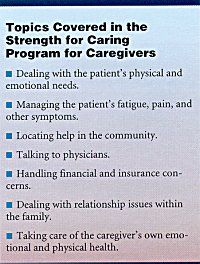How Employers Can Help Caregivers in the Workplace
NEW YORK-In an age when hospital stays are shorter and acute diseases more chronic, family caregivers are increasingly seen as extensions of the health care system. Yet often they receive scant preparation from health care providers and little support or understanding from their employers. Establishing programs to help caregivers was the subject of a Cancer Care, Inc. teleconference.
NEW YORKIn an age when hospital stays are shorter and acute diseases more chronic, family caregivers are increasingly seen as extensions of the health care system. Yet often they receive scant preparation from health care providers and little support or understanding from their employers. Establishing programs to help caregivers was the subject of a Cancer Care, Inc. teleconference.
Weve just emerged from an era in which birth, death, and most of the sickness in between were managed in an institutional setting, said Frances K. Barg, PhD, University of Pennsylvania School of Nursing, and coordinator of the Strength for Caring Program. Although it never was much like home, most of us came to rely on the security of trained professionals carrying for our loved ones, but most of that has changed now.
Despite these shifts to home care, health care professionals are often unwilling or unable to take on the job of training the caregivers, Dr. Barg said. She cited a recent survey of staff in New York hospitals, conducted by the United Hospital Fund of New York, in which respondents stated they had to devote their limited time and financial resources to patients, not caregivers. [Levine C: Rough Crossings: Family Caregivers Odysseys Through the Health Care System. Special Report, United Hospital Fund, 1988.]
The staff were also less comfortable in dealing with psychosocial issues as opposed to physical aspects of care. Language and cultural issues were also cited as barriers to working with the family.
The lack of preparation, the demands on their daily life, and the impact on their family and jobs combine to cause resentment, clinical depression, family problems, a loss of financial resources, and, according to several studies, illness, death, and even suicide, Dr. Barg said.
Studies have also shown that caregivers who have a history of depression, have medical problems of their own, or have been caregivers for 6 months or longer are at special risk.
Spousal caregivers will have different issues than adult caregivers of a child, and caregivers unrelated by blood or marriage may have unique problems. Many times, caregivers who are not related to the patient feel very disenfranchised by the health care system, Dr. Barg said. They have few rights to information and often do not receive the same type of support from others.

Counseling programs can facilitate a caregivers adjustment, she said. The Strength for Caring Program developed at the University of Pennsylvania School of Nursing is one such approach. It is a 6-hour support and education program for people caring for a loved one with cancer at home (see Table).
Supported and disseminated by Ortho Biotech, the Strength for Caring Program is offered in doctors offices, hospitals, and other community settings, and is also available to companies wishing to offer it to employees.
Many employers believe that caregiving is not a workplace issue and that programs that address these concerns cost too much money. This is not the case, said Gail Hunt, executive director of the National Alliance for Caregiving, a coalition of 25 national organizations. Ms. Hunt said there are many low-cost or no-cost ways to help caregivers in the workplace. Most companies have some kind of benefits for employees that could help caregivers. These include leave of absence, flex time, and telecommuting.
In addition, employers could direct employees to websites offering information to caregivers. They could hold seminars for caregivers and support groups during lunch or at the end of the day. The human relations department could provide resource directories from the local department of the aging.
Preretirement planning seminars offer an opportunity for discussing care-givers concerns. The company might include articles about caregiving in the employee newsletter or make information available in the cafeteria, including information about help available through the human relations department.
Ms. Hunt cautioned that employers who do make schedule adjustments for caregiving employees must be careful not to do so by creating hardships for other employees. This is an issue that comes up in child care, too. Without violating the confidentiality of the caregiving employees, companies should provide opportunities for employees to discuss these issues together with the line supervisor so they can work together and come up with a solution, she advised.
Employees at Ortho Biotech, along with those of other Johnson & Johnson companies located near their main campus in New Brunswick, NJ, are taking part in the Strength for Caring Program, according to Mike Thomas, vice president of human resources, Ortho Biotech. The program is held in three consecutive lunchtime sessions, 1½ hours each.
The events are heavily promoted in advance. Employees register confidentially and are provided with written confirmation and brief background information prior to the meeting, Mr. Thomas said. About 10 to 15 employees from various levels and functions of the company participate in any given session, and the events are moderated by a trained Strength for Caring facilitator.
The response to the Strength for Caring program has been really tremendous. Our employees feel validated in their role as caregivers and really supported by their employer, Mr. Thomas said.
Newsletter
Stay up to date on recent advances in the multidisciplinary approach to cancer.








